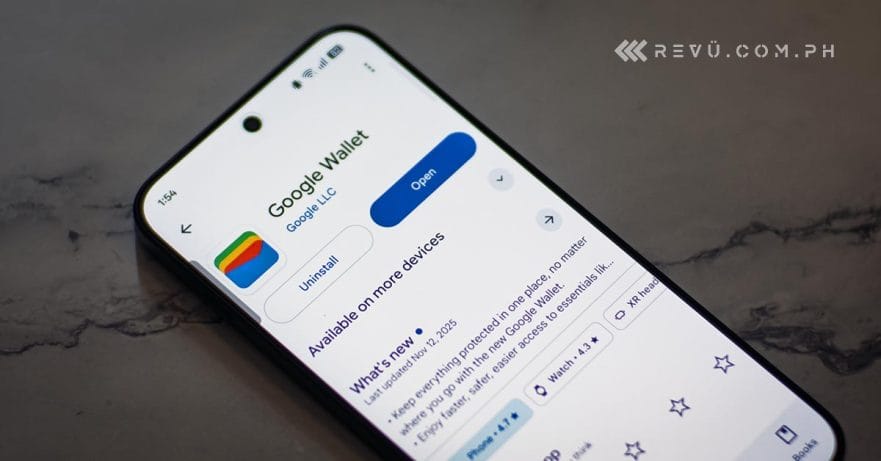It’s finally happened. After years of watching other countries tap their phones and watches to pay for everything, Google Wallet has officially launched in the Philippines.
Chances are, your physical wallet is probably a mess. It’s bulky, stuffed with faded receipts, expired loyalty cards you forgot you had, and a dozen different payment cards. Google‘s pitch is simple: Let your Android phone handle all of it in one secure, digital space.
This launch also marks a major push for what technology executives and government officials call “financial inclusion” and aligning with the Philippines’ digitalization agenda.
So, what is this, how do you use it, and is it time to ditch your leather bifold? Let’s get into it.
First, let’s clear this up: Google Wallet vs. Google Pay. This might be confusing for some, so let’s make it simple. Google Wallet is the app, the digital “container” on your Android smartphone. It holds your digital stuff: payment cards, loyalty passes, boarding passes, event tickets, and more. Google Pay is the service that handles the actual transaction.
Think of it like this: Your debit card sits in the Google Wallet, and when you tap to pay, Google Pay is the tech that securely completes the purchase.
How to get started and use Google Wallet
Ready to go digital? The setup is pretty straightforward.
- Set up your smartphone and add a card. First, your device needs near-field communication of NFC to do the tap-and-pay magic. If you have a recent Android handset or Wear OS device, you’re likely good to go.
- Download the Google Wallet app from the Google Play Store.
- Sign in with your Google account.
- To add your first card, tap the “Add a card” button. You’ll scan your card or enter the details manually. You’ll need to review and accept your bank’s terms and then complete a verification process, usually a one-time password. Once verified, your card is ready.
How to pay in stores: The ‘tap-and-pay’
This is the main event.
- Unlock your phone. You don’t even need to open the app.
- Hold it near the reader. Look for the contactless-payment symbol — you know, the little Wi-Fi-looking wave — on the store’s card terminal.
- Wait for the checkmark. You’ll see a checkmark on your device’s screen and hear a tone, confirming the payment was successful.
How to pay online or in apps
This might be even easier and saves you from typing your card details on sketchy websites.
- At checkout, look for the “Buy with Google Pay” or “Google Pay” button. You’ll already see this on places like Shopee.
- Select it.
- Confirm your payment method and shipping address.
- Complete the purchase.
Not just for money: The real upgrade
This is where Google Wallet separates itself from a simple payment app. It’s designed to replace everything in your wallet. For travel, you can add boarding passes from carriers like Philippine Airlines, AirAsia, Cathay Pacific, and Singapore Airlines. The app will even notify you of gate changes or departure time delays. Instead of carrying around extra plastic, you can add your IKEA Family card and Mang Inasal vouchers right into the app.
In a huge local win, you can even use Google Wallet for transit. It works for tap-and-pay at the MRT-3 and on modern jeepneys in Cebu and Mandaue City. Support for tickets purchased through the Beep app is also listed as “coming soon.” On top of that, event tickets from Ticket2me and Ticketnet can be stored, saving you from searching your email inbox while standing in line.
Adding these is just as simple. After you buy a ticket or flight, you’ll often see an “Add to Google Wallet” button. Click it, and the digital pass is saved.
Who’s on board at launch
A digital wallet is useless if no one accepts it. Google did its homework and launched with a solid list of partners.
- Banks and financial services
- Visa and Mastercard: ChinaBank, East West Bank, RCBC, and Zed
- Visa: GoTyme, Maya, UnionBank, and Wise
- Mastercard: ChinaBank and GCash
- Merchants and partners
- Online shopping: Shopee, Sephora (coming soon), and merchants supported by PesoPay, Payermax, Paymongo, and Maya
- Airlines: Philippine Airlines, AirAsia, Cathay Pacific, Jetstar, Malaysia Airlines, Singapore Airlines, Scoot, and Thai Airways
- Travel/tickets: Trip.com, Ticket2me, Ticketnet, and Easybook
- Loyalty/vouchers: IKEA, Mang Inasal
But is it safe?
This is the No. 1 question. You’re putting your whole financial life on your smartphone.
Google Wallet is built on a security framework called tokenization. That means when you tap to pay, the app doesn’t send your actual credit card number to the merchant. Instead, it uses a device-specific alternate card number (a “token”) with a dynamic security code that changes for each transaction. The merchant never sees your real info.
On top of that, your bank has to approve the card being added; your device’s screen lock — fingerprint, face, or PIN — is required to access the wallet; and if your phone is lost or stolen, you can use “Find My Device” to instantly lock it, set a new password, or wipe your personal info completely.
This is a big step. With banks, e-wallets, airlines, and even the MRT on board, Google Wallet may very well be a powerful, secure, and incredibly convenient tool that, for many Filipinos, will be the new center of their mobile-first digital life.
Google’s press release
Share this Post



